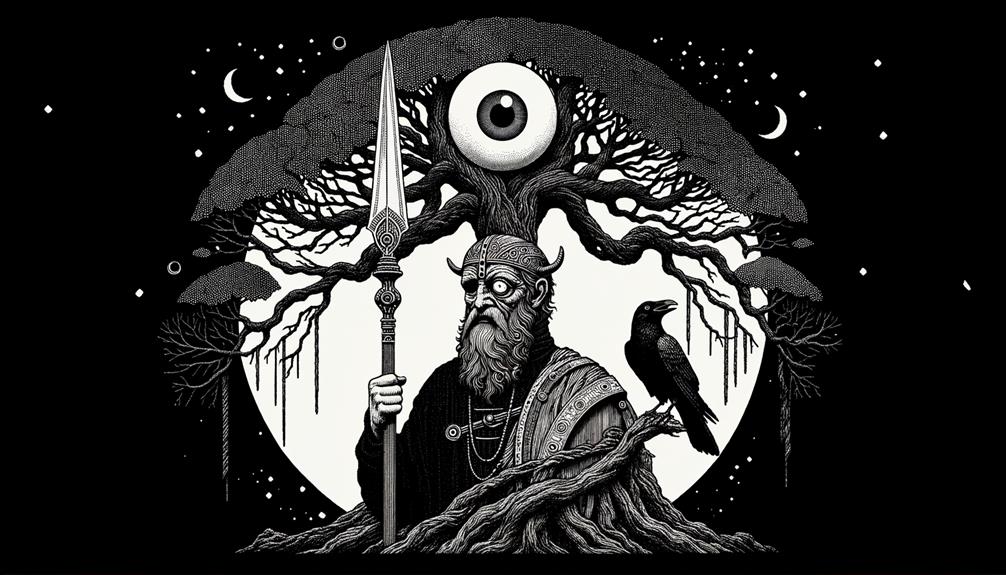Odin’s sacrifice on the cosmic tree Yggdrasil is a highlight of Norse mythology, signifying his relentless pursuit of knowledge. He spent nine days and nights hanging from Yggdrasil, an ordeal that transformed him into the most knowledgeable of all Norse gods. But his sacrifice didn’t stop there. Odin also gave up an eye at the well of Mimir, swapping his physical prowess for deep understanding. This well, found within the roots of Yggdrasil, is known for its magical waters that bestow wisdom upon those brave enough to pay the price. Odin’s actions serve to highlight his unwavering commitment to uncovering the universe’s mysteries. Read on for more intriguing details about this story.
Unveiling Odin’s Quest for Wisdom
You might find it a bit much, but when Odin decided to hang himself from the holy World Tree, Yggdrasil, for a strenuous nine days and nights, it was all for the pursuit of wisdom. His determination to withstand such a severe trial, just to gain the ultimate wisdom, shows his deep dedication. Using the World Tree as his backdrop, Odin took it upon himself to unravel the secrets of the universe and learn about the enigmatic runes. This personal journey was a turning point for Odin, transforming him into the most knowledgeable of the Norse gods. His dedication to wisdom is evident in his actions, and he was willing to put his own well-being, and even his life, on the line to understand the universe’s complexities. Odin’s time on Yggdrasil is a testament to his never-ending search for wisdom.
The Symbolism of Yggdrasil
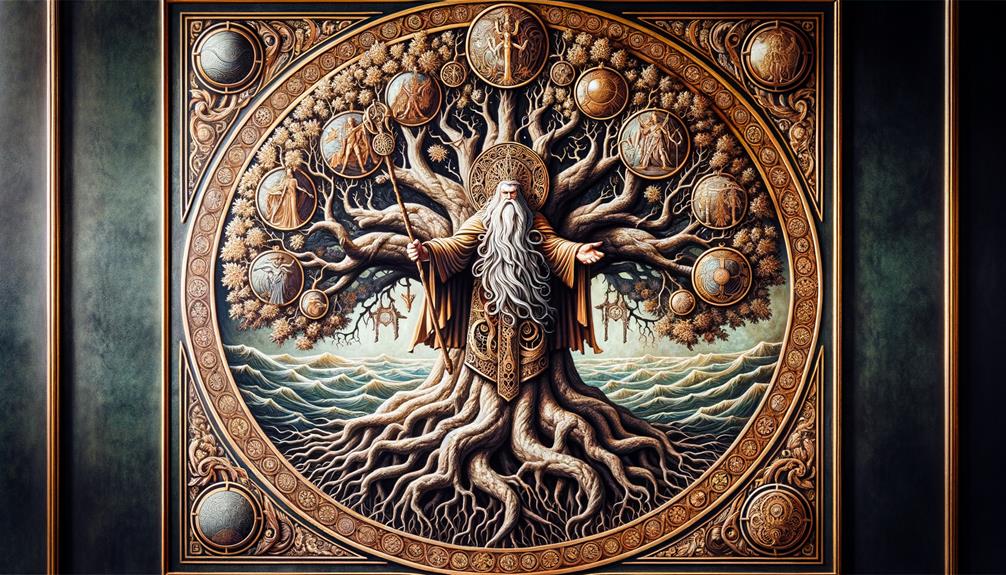
When we delve into the symbolism of Yggdrasil, we quickly understand its central role in Norse mythology. Think of it as a cosmic tree that serves as an anchor point for the universe and its various domains.
Now, let’s talk about its roots. In Norse cosmology, the roots of Yggdrasil symbolize the connection between different worlds. Picture this mighty ash tree with its three roots, each one supporting a different world. This visual gives us a sense of unity amidst diversity.
But Yggdrasil isn’t just about space and connections. It’s also about knowledge and sacrifice, particularly in the story of Odin. The tree is a testament to Odin’s sacrifice in pursuit of wisdom. It emphasizes life’s cyclical nature, death and the endless quest for knowledge.
Odin’s Self-Sacrifice: Eye for Knowledge
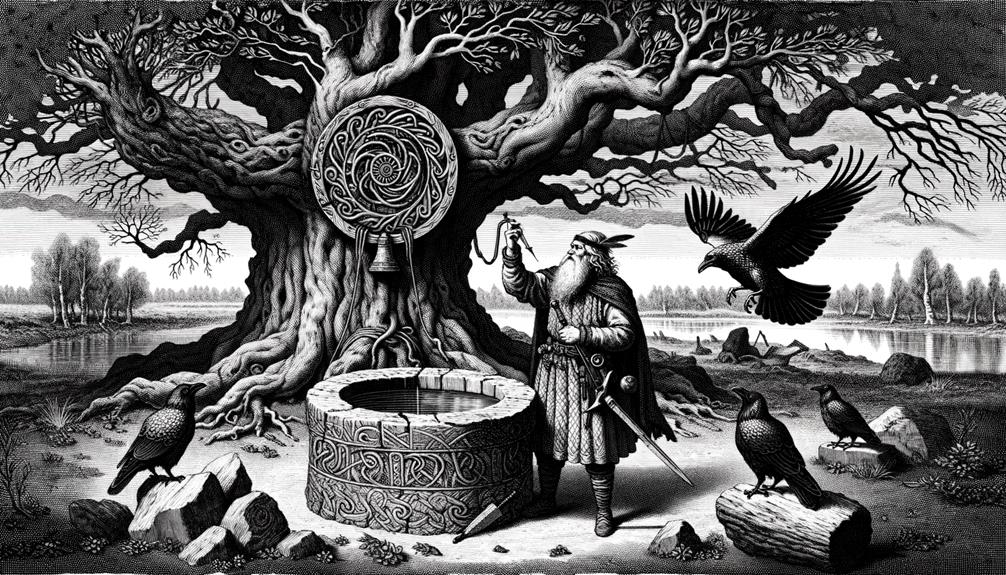
When we dive into Odin’s story, we find a compelling narrative of wisdom and enlightenment. He did something pretty incredible. He gave up one of his eyes at Mimir’s Well, located at the base of Yggdrasil. But here’s the thing: Odin didn’t lose his eye in a fight or out of desperation. He willingly gave it up. It was a conscious choice, driven by his relentless desire to gain knowledge.
Mimir, the guy who watches over the well, was the one who set this whole thing up. In exchange for Odin’s eye, he gave Odin an understanding that went beyond what any human or god could comprehend. This tremendously significant event catapulted Odin to the top, making him the wisest of all the Norse gods.
It’s fascinating how Odin’s sacrifice symbolizes the pursuit of wisdom, even if it means going through personal hardship. It really brings home how much the Norse culture valued wisdom over physical strength.
The Mimir’s Well: A Deep Dive
Alright, let’s chat about the fascinating role that Mimir’s Well plays in this story. You see, this well, tucked away amongst Yggdrasil’s roots and under the watchful eye of the smart Mimir, contained magic-infused waters. These waters had the power to grant wisdom, but only to those brave enough to pay a hefty price.
Take Odin, for instance. He gave up an eye to sip from this well. And what did he get in return? He emerged as the most knowledgeable god, a testament to his steadfast dedication to pursuing the truth. This act also stands as a powerful symbol of his unwavering commitment to gaining true knowledge.
Understanding Mimir’s Well
Ever wondered about Mimir’s Well and the mysteries it holds? This ancient spring of wisdom is a big deal in Norse mythology. People who are brave enough to seek its knowledge might just find what they’re looking for. You might also hear it being called the Well of Urd.
This well is situated right in the mix of Yggdrasil’s roots. It’s a go-to spot for knowledge seekers like Odin. Mimir, the guy who watches over the well, is famous for his exceptional wisdom. This makes his well a popular stop for anyone hungry for the real deal in wisdom.
There’s a story that the well’s magical water gave Odin a serious wisdom upgrade. He gained insights into everything – the past, the present, and the future. Odin hanging from Yggdrasil was his big sacrifice for wisdom. It just goes to show how far he would go to gain enlightenment.
This story really drives home the idea of sacrificing for wisdom in Norse mythology. It shows just how much they valued the search for genuine knowledge.
Odin’s Eye Sacrifice
If you’re interested in Norse mythology, you definitely can’t ignore the story of Odin’s eye sacrifice. It’s a pretty intense tale about what Odin did to gain wisdom. So, there’s this well, guarded by Mimir, and it’s said to be a source of incredible wisdom. The catch? To access that wisdom, Mimir asked Odin to sacrifice his eye. Without a second thought, Odin did just that, driven by his desire to know more.
Now, this wasn’t just a casual event. It was a major turning point for Odin because it catapulted him to the top, making him the wisest of all the Norse gods. After he drank from Mimir’s Well, he could see into the past, present, and future. It’s a real testament to the link between sacrifice and wisdom, especially when you think about Odin’s character in Norse mythology.
Yggdrasil’s Role Revealed
Dive into the depths of Yggdrasil, the grand World Tree that forms the backbone of the Nine Worlds in Norse mythology. Nestled within its roots is Mimir’s Well, a source of wisdom and knowledge as vast and deep as the universe it exists in. The tree and its well are a package deal – you can’t separate one from the other. The importance of Yggdrasil comes to light when you think about Odin’s sacrifice.
Odin, who was always on the hunt for wisdom, gave up one of his eyes to the Well. This act of giving up a part of himself, which shows just how committed he was to his pursuit of knowledge, transformed him into the most knowledgeable god of them all. It’s a powerful image that shows just how far some will go in their search for enlightenment and highlights the depth of wisdom and knowledge. As such, Yggdrasil and Mimir’s Well take on a symbolic role in this celestial pursuit of wisdom, a role that’s made all the more important by Odin’s sacrifice.
The Rune Mysteries: Odin’s Discovery
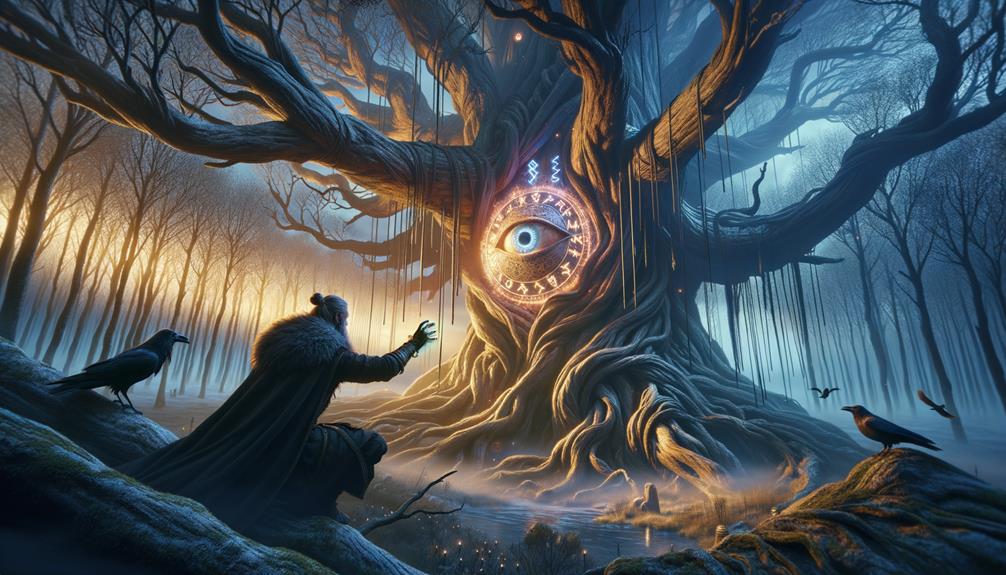
Odin, in his quest for wisdom, chose to go through a self-imposed trial on Yggdrasil. He hung for nine days and nights, pierced by his spear, in order to understand the powerful secrets of the runes. The Norns, those enigmatic fate spinners, had carved these symbols into Yggdrasil, filling the Nine Worlds with deep wisdom. Odin‘s self-sacrifice, a symbolic casting off of his base self, was a critical act that unveiled these rune secrets. The runes revealed themselves, gifting Odin with control over magic and exceptional powers. This transformational experience established Odin as a central character in Norse mythology, his passion for wisdom encouraging many. With this newfound wisdom at his disposal, he was prepared to impact and transform his world.
The Impact of Odin’s Sacrifice Today
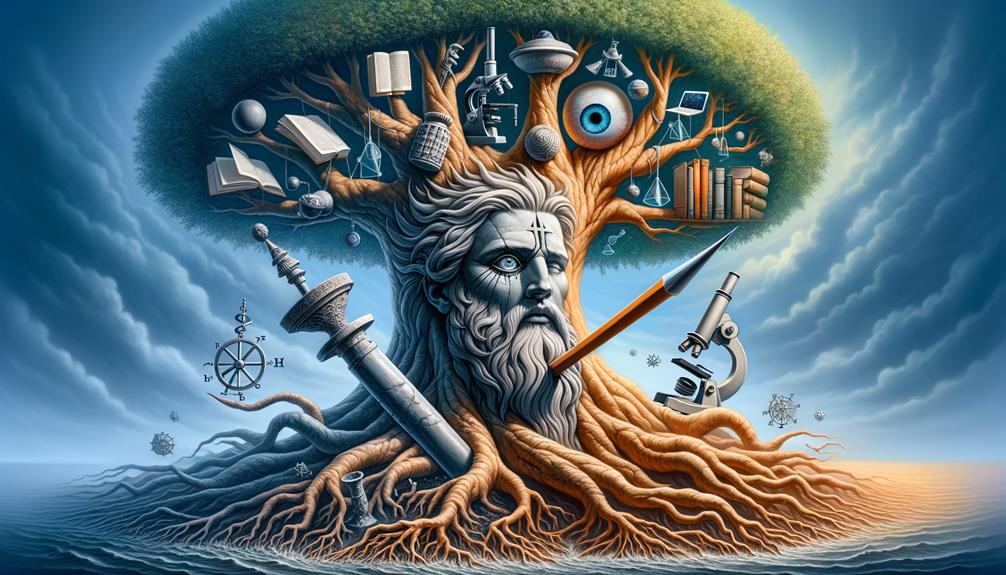
Odin’s act of self-sacrifice on the tree Yggdrasil echoes into our present day, acting as a testimony to the enduring worth of wisdom and personal change. This key event in the Norse mythology demonstrates the extent to which one can go to seek wisdom. Odin’s actions of hanging from the tree and gazing into the well symbolize selflessness and personal sacrifice, virtues that are still highly valued in our current society. His sacrifice teaches us that the quest for wisdom often involves personal sacrifice, and these efforts are never without merit. We, in today’s society, continue to draw motivation from this story, understanding that the journey to enlightenment often demands self-change. So, Odin’s self-sacrifice on Yggdrasil stands as a shining example of the lasting significance of wisdom and selflessness in our lives.
Frequently Asked Questions
Which I Did Odin Sacrifice?
Odin, the Norse god, gave up one of his eyes in his quest for wisdom. This self-inflicted sacrifice is steeped in symbolism that harks back to Norse rituals and mythology. It shows the importance of the world tree, Yggdrasil, in Odin’s journey towards acquiring knowledge.
What Was a Sacrifice to Odin Myself to Myself?
The tale of ‘Odin giving himself to himself’ is a deeply meaningful story of self-sacrifice for the pursuit of wisdom. It represents a spiritual transformation, a symbol that holds a significant place in Norse rituals. This story showcases Odin’s mythical influence and illustrates his dedication to gaining divine knowledge. In a way, it was Odin’s way of showing just how far he would go for wisdom, which is truly a testament to his character.
Does Ragnarok Destroy Yggdrasil?
Although Ragnarok’s force does rattle Yggdrasil, it doesn’t completely obliterate it. Norse end-of-the-world theories imply that Yggdrasil may endure, suggesting a resurgence after Ragnarok. This destiny of the World Tree symbolizes the circular pattern of life.
What Is Odin’s Noose in Norse Mythology?
You know Odin’s noose, Gungnir, right? It’s a big deal in Norse mythology. The noose is basically a symbol of how much Odin valued wisdom. He was so into learning and knowledge that he was willing to give up a lot for it, even himself. So, Gungnir is like a reminder of that whole self-sacrifice thing. It’s deeply tied to Viking traditions and the way they saw sacrifice as a means to gain more knowledge. Understanding what Gungnir represents helps us understand who Odin was and what those old Norse rituals were all about.

